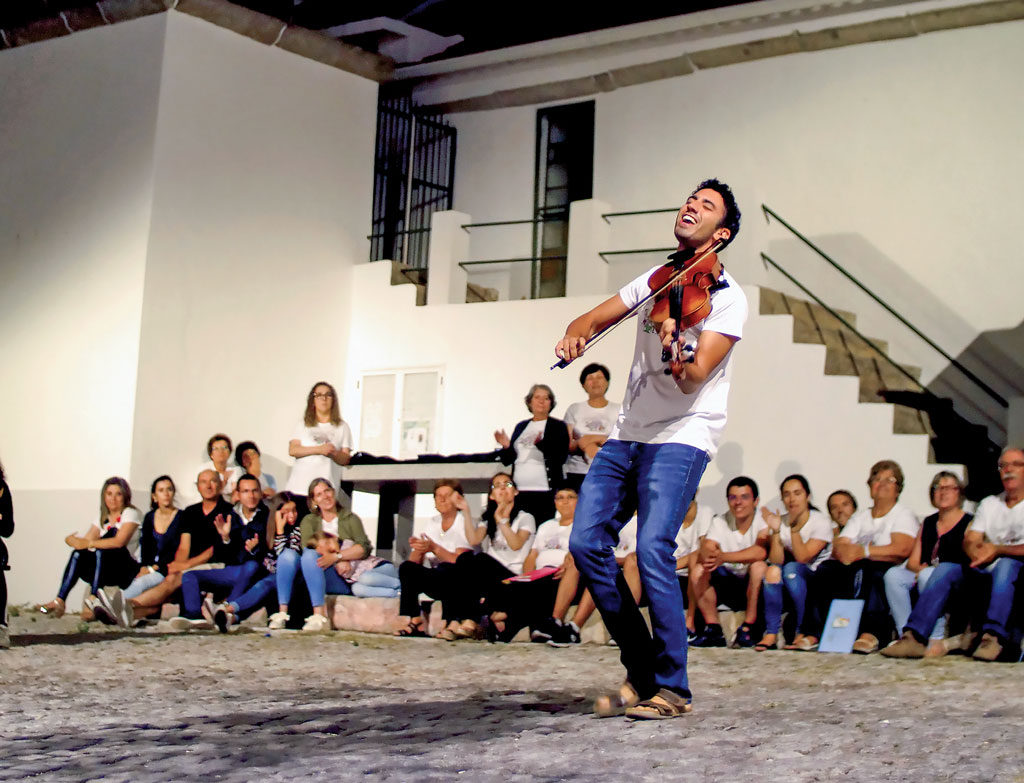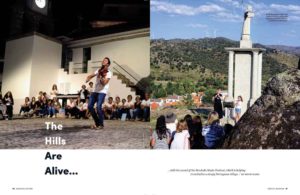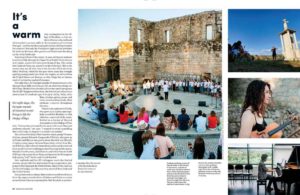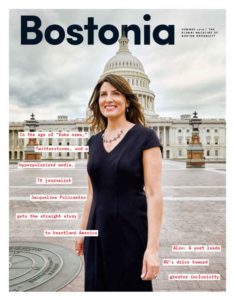Bostonia‘s six-page print treatment of the Bendada Music Festival feature (below) is tactile, informative, and inspiring.
The online treatment of the same story is made immersive through the elegant use of multimedia and interactive elements. Click the image below to view the page on Bostonia‘s website.
To Each Its Own
Bostonia leverages multiple platforms for outstanding results.
By Tony Silber
Online, you will find yourself in this 2,000-year-old village, riding shotgun as a Portuguese journalist steers his way past the stone houses of Bendada during the opening scene of a 14-minute video. You’ll see the quiet streets and hear the strain in your host’s voice as he explains how local youth have been leaving the town to find their futures elsewhere.
You’ll glimpse the dedication of the local and visiting musicians and their instructors in a dozen photo stills that capture their rehearsals in black and white before, as you scroll down the page, these images render into living color. And then you’ll hear the music — in a church, in the town center, against the backdrop of those stone buildings — in three short videos and a single haunting audio clip. In other words, you’ll experience the Bendada Music Festival.
This is how the story of a classical and traditional music event founded by Boston University doctoral student Ines Andrate is presented on the Bostonia website, digital home of Boston University’s alumni magazine (tinyurl.com/BUBendada). The event, encompassing eight days of musical classes and performances, brings a remote, 200-person Portuguese village to life each summer.
You’ll see this same feature in print as well. In the pages of Bostonia’s Fall 2018 issue, you’ll find a tasteful and striking six-page layout in which this same story is told – 1,050 words recounting the festival’s founding and its impact on the town intermixed with beautiful, emotive, still images. Here, the story is tactile, leisurely, informational, and inspiring.
And this is the goal of Bostonia’s creative team: To use each medium to its best advantage. To not fall prey to the all-too common trap of simply trying to replicate print stories online, or vice versa. And instead, to leverage the qualities and strengths of each platform in a way that builds upon and reinforces the other.
“That was the big thinking,” says Executive Editor Doug Most, describing the goal of the online presence Bostonia has been nurturing over the last decade. “To extend the brand beyond print into the digital landscape, and to do it in a way that is striking and immersive but still feels like a magazine.”
Not just a magazine, but Bostonia, Boston University’s storied alumni publication, a centenarian founded in the first year of the last century. The magazine has chronicled the BU community for 119 of the institution’s 149 years. Mailing out three times each year to 350,000 graduates, it serves as the glue that binds the alumni diaspora together — a physical, tangible connection to the university and a channel for updates on the school’s contemporary activities. In this day of digital domination, the print magazine remains vibrant and relevant. “It’s still the one thing that gives all of our alums the total experience, at their fingertips, that they wouldn’t find through a search engine,” says Senior Vice President of External Affairs Stephen Burgay.
The print magazine has the smart look of a Bloomberg Businessweek or an Inc., a look designed to appeal to its highly educated and well-connected readership. It also guides the look, feel, and tone of the online version. “Our creative director, Jon Brousseau, looks at the print magazine as a development document,” says Bostonia Editor Cindy Buccini. The website develops the best components of the print presentation in ways that exploit the creative potential of the medium. “With digital, we wanted to further engage readers by giving them a sense of being fully immersed in each story,” says Buccini.
This sense of immersion, of experiencing the topic at hand, is ubiquitous in Bostonia online. Yet it is at the same time subtle, never jarring or distracting. Photos and headlines debut in black and white, then render into color as you scroll over them. Interactive displays are plentiful. For example, “Finding Hope for Syrian Refugees,” a 2,600-word Q&A from Fall 2017, includes a mesmerizing interactive graphic showing global refugee flows from 2000-2015 (tinyurl.com/BURefugeeMap). A 3,800-word piece on Crystal Williams, the university’s first senior diversity officer, shares the administrator’s talent for poetry with a video of her reciting one poem and an audio clip of another (tinyurl.com/BUWilliams).
An article from the Fall 2018 issue featuring three high-profile 2018 Congressional candidates with Boston University connections — Alexandria Ocasio-Cortez (now New York Rep.-elect), Gina Ortiz Jones, and Ayanna Pressley (now Massachusetts Rep.-elect) — employs video, photography, and graphic design to engage the audience, and, equally important, keep them reading (tinyurl.com/BUCongress). The online version breaks the 3,500-word story into components, each focusing on one young political aspirant. “This is a long story,” Most, the executive editor, says. “But when you open it digitally, it feels easily digestible.”
And that’s the point. Immersion becomes visceral and experiential when you’re showing the story and not just telling it. “We want to be visual,” Most says. “We’re trying to reach a [younger, digitally savvy] audience and get them to engage.” As the Bostonia reader demographics change, Most says, the brand must change with them. “There are many ways you can present stories, and we’re trying to present them visually as much as possible,” he adds.
The Road to Renewed Relevance
Bostonia set out to retool its online approach in late 2008, driven by changing demographics and a desire to amplify its marketing efforts. Alumni, especially younger ones but Baby Boomers as well, were becoming more comfortable with digital media and were more likely to engage with Bostonia via the internet. “It was clear to us that much of the world was online,” Burgay says. “It was really important to establish a presence in the digital realm. It allowed us to be where our audiences were going for news and information.”
Demographics aside, one of the most strategically important objectives in going online was to provide a highly accessible platform and marketing tool for Boston University’s research. Bringing Bostonia online, Most says, allowed the communications team to elevate awareness of the university’s research expertise — expertise showcased in 5,790 research-related articles published in 2017, and nearly $487 million in research awards granted in fiscal year 2018. More than 200 companies are selling products based on BU research discoveries, and the university is one of 62 members of the invitation-only Association of American Universities, an organization of leading research universities.
“It’s one of our highest strategic objectives,” Most says. “People go online to look for authoritative and current research on, say, Alzheimer’s. Or heart disease. Or infectious diseases. And now they’re able to find their way to articles and research we publish about those topics.” Engagement starts with an organic Google search. “They search on a topic, and then they go to a [BU] landing page,” Most says. “That’s the strategic context for going online and investing significantly to make sure it’s a high-quality, credible presence.”
There are additional benefits, too. Online content can be shared. It can go viral. It has no expiration date. It’s not limited by geography. “A great advantage of the web is that it’s always there and accessible to anyone at any time,” says Art Jahnke, a contributing editor and former executive editor. “Content goes sideways. People don’t go to the homepage of a website and find what they want to read. Stories travel around the web from person to person,” a trend accelerated by social media, Jahnke notes.
“If you put stuff up there, it’s there forever, and if it’s good, it makes its ways around the web,” Jahnke adds. “Plus, anyone who has a mobile phone can read Bostonia at any time.”
Making It Happen
Before these revelations, Bostonia’s online presence consisted of a static website where content was reposted from the print magazine. The template was neither design friendly nor interactive, nor was it built with the user experience in mind, Burgay recalls.
“We wanted to embrace the medium, and we saw where the trends were going,” Creative Director Jon Brousseau says, noting both the general shift of readers from print to online and the fact that those “readers” were watching or listening as much or more than they were actually following words in print. By the beginning of the 2010s, the “pivot to video” was well established, with content creators shifting emphasis from the written word to a television-like format.
For the team at Bostonia, that would mean hiring five videographers in the years since 2008. The group now produces up to six videos each month, including Q&As with university personalities and backgrounders on campus initiatives. In addition to creating its own video, Bostonia collects video content from publicly available sources to work into its online presentations. The varied perspective adds a depth and authenticity that’s hard to capture in shop-produced video alone, and enables the team to tap into a wide variety of available media.
Breaking the Institutional Mold
Fresh thinking on content has also meant fresh thinking on internal organization. Before 2008, BU’s publication professionals operated independently, with separate groups creating content for university-wide and college-specific publications with little coordination and sharing of material or resources. “We knew we had to change,” Jahnke recalls.
Burgay reorganized the department so content producers write for all publications, and their work gets distributed and repurposed through various channels as appropriate. This group shares one workspace and operates, as Jahnke describes it, as a single “factory” under Most’s leadership. “Ten years ago, everything was in silos,” Jahnke says. “Now, content moves around. It’s like a menu. Publishing online encouraged greater consolidation of writers and editors, and that has in turn improved the print product and given us a broader amount of content to draw from.” This reorganization powers increased output and greater efficiency, as well as a more collaborative ideation process, the editorial managers say.
In addition to producing content for Bostonia and its website, the 17-person editorial operation supplies material for Research Magazine and its website; the daily news site BU Today (www.bu.edu/today); and a monthly email newsletter, Bostonia Extra, which reaches about 168,000 people. It also produces content for publications issued by nine of the university’s 17 colleges. While Cindy Buccini heads up Bostonia, Kat McAlpine is editor of Research, and John O’Rourke is editor of BU Today.
The consolidated group is prolific. BU Today publishes 15-20 stories per week. Of those, a handful appear on Bostonia’s and Research’s websites, depending on the subject matter. Some stories appear first on Bostonia and Research and then are repurposed to appear on BU Today.
A Focus for the Next 10 Years
Five years after its latest website redesign in 2013, Bostonia is setting its sights on a refreshed design and new content management platform, scheduled to launch in mid-2019. This time, primary emphasis will be on enhancing Bostonia’s mobile experience for an increasingly peripatetic audience. “The new site is going to be conceived with mobile first in mind,” says Brousseau. As with the 2013 update, there will be some visual changes on the front end, but most of the updates will be under the hood, in the coding, Brousseau explains. Again, to enable a user experience that fits the medium. “In mobile, there are different ways to handle captions on the small screen versus a large screen, for example. There are differences between a touch device and a click device. There are a ton of things involved.”
As there is, the Bostonia team knows, in the telling of every one of the stories they present on multiple platforms. The story of the Bendada Music Festival, captured in sight and sound as well as in written narrative, serves as both an example of the opportunities offered online and the culmination of Bostonia’s effort to embrace them. “Digital allowed us to branch out into multimedia,” Burgay says. “We invested in videography and our Interactive Design group. Now we look at stories and features in every edition that we want to bring to life in ways that you can’t do in print alone.”
Tony Silber is president at Long Hill Media, a content-creation company. After starting out as a newspaper journalist, he chronicled the early years of the commercial internet as executive editor of Internet World and then ran Folio:, the magazine for print-magazine management, for many years, including as it transitioned into an online-only product. Connect via silber@pagesthemagazine.com.







